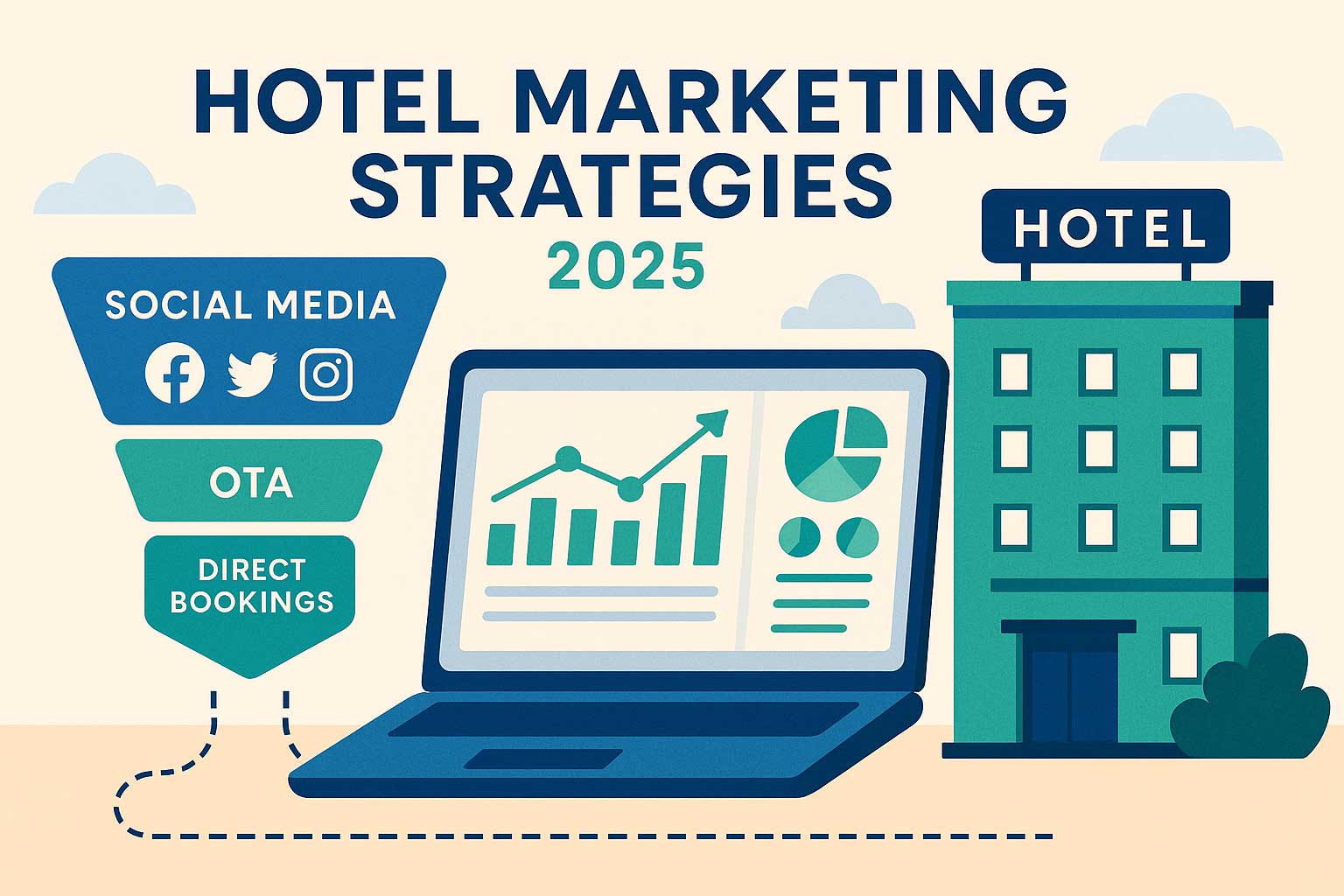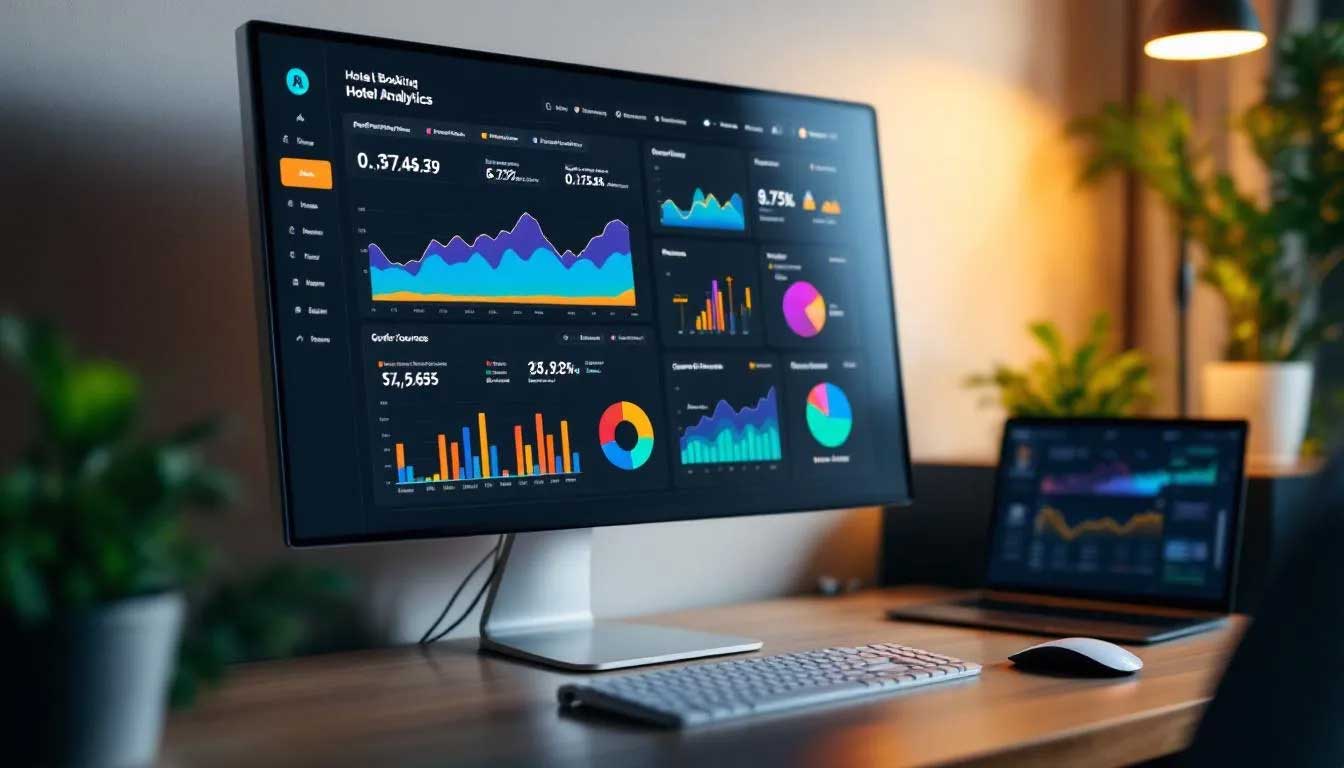Hotel Revenue Management: Complete Guide to Maximizing Profitability in 2025
Jul 31, 2025
 Mika Takahashi
Mika TakahashiPopular Categories
Hotel Technology & InnovationHotel Operations OptimizationDigital MarketingIndustry TrendsRevenue ManagementHospitality Industry
Popular Categories
Trending Post

Hotel Walk Letter Template: Professional Guest Communication

Online Travel Agents: What They Are and How They Work

Hotel Security Systems: Modern Protection Solutions

Hotel Advertising: Complete Guide to Boost Bookings and Revenue

25 Hotel Marketing Strategy Ideas for 2025: Complete Guide

AI Reservation Agent: Revolutionizing Hotel Booking and Guest Experience

PMS Communication: Streamlining Property Management Through Effective Guest Messaging
Table of contents
In 2025, hotels that master hotel revenue management are pulling ahead, generating 15-25% more revenue than their competitors. Meanwhile, those sticking to outdated pricing tactics find it harder to stay profitable amid rising costs and fierce competition. The key to thriving in today’s hotel industry is mastering the art and science of selling the right room to the right guest, at the right price, and at the right time.
Hotel revenue management has come a long way from simple seasonal rate tweaks. Today’s hotel revenue managers use powerful analytics, artificial intelligence, and real-time market data to make thousands of pricing decisions daily that directly impact their hotel’s profitability. With travel patterns still shifting post-pandemic, economic uncertainty influencing guest behavior, and alternative accommodations reshaping the market, effective revenue management is more important than ever.
This comprehensive guide will provide you with the strategies, essential metrics, and tools you need to optimize your hotel’s revenue in 2025 and beyond. Whether you’re a seasoned revenue manager or a hotel owner aiming to boost your bottom line, you’ll find actionable insights to transform how you handle pricing, managing inventory, and guest acquisition.

What is Hotel Revenue Management?
Hotel revenue management is a strategic approach that blends data-driven analysis, demand forecasting, dynamic pricing, inventory optimization, and channel management to maximize a hotel’s overall revenue and profitability. At its core, it’s about selling the right room to the right guest at the right time, at the right price, and through the right channel.
This modern approach goes well beyond traditional yield management, which focused mostly on maximizing room revenue through simple price changes. Today’s hotel revenue management covers a wider scope, optimizing all revenue-generating areas—including food and beverage, spa services, meetings and events, and other ancillary revenue streams.
Several factors have driven this evolution:
- Advanced analytics that process vast amounts of historical data and market intelligence
- Real-time market monitoring that keeps an eye on competitor pricing and demand signals around the clock
- Customer segmentation tools that identify distinct guest profiles and their willingness to pay
- Integrated technology platforms connecting revenue management software with property management, customer relationship management, and distribution systems
By leveraging machine learning algorithms, today’s revenue management solutions identify booking patterns, predict demand shifts, and automatically adjust pricing based on hundreds of variables. This lets hotels make pricing decisions multiple times a day, reacting instantly to market changes that used to take weeks to spot.
It’s important to understand the difference between revenue management and yield management. Yield management focuses on maximizing income from perishable inventory like hotel rooms, while revenue management takes a holistic view, considering the guest’s total value across all touchpoints during their stay and potential future visits.
Why Hotel Revenue Management is Critical in 2025
The hospitality industry faces unique challenges in 2025 that make effective hotel revenue management essential for survival and growth. Hotels that don’t adapt their revenue management strategies risk losing market share and profits.
Post-Pandemic Travel Pattern Disruptions
Travel behavior has shifted dramatically since the pandemic, complicating demand forecasting. Business travel remains below pre-2020 levels in many markets, while leisure travel has surged with different booking patterns and price sensitivities. The rise of remote work has blurred the lines between business and leisure, creating “bleisure” travelers with unique booking habits and accommodation needs.
Revenue managers need to rethink customer segments and adjust pricing strategies to keep up. Traditional forecasting models based on past data may no longer be reliable, so real-time analytics and flexible pricing algorithms are crucial.
Economic Volatility and Price Sensitivity
Economic uncertainty, inflation, and changing consumer confidence have made travelers more price-sensitive. Hotels must carefully balance maintaining revenue levels without pricing themselves out of reach for budget-conscious guests.
Dynamic pricing strategies play a vital role here, allowing hotels to quickly adjust rates based on demand signals and test different price points to find the sweet spot for each market segment. Revenue management software that models price elasticity and guest responses helps make smarter pricing decisions.
Rising Operational Costs and Labor Challenges
Hotels continue to face labor shortages and rising costs for utilities, food, and maintenance. These expenses squeeze profit margins, making it even more important to focus on maximizing gross operating profit per available room (GOPPAR), not just occupancy or average daily rates.
Modern hotel revenue management strategies emphasize analyzing all revenue streams and their costs to drive true profitability.
Intensified Competition from Multiple Sources
Competition is fierce in 2025. Online travel agencies (OTAs) still dominate with heavy marketing budgets and take commissions of 15-25% per booking. Alternative accommodations have also matured, especially in leisure markets.
This means revenue managers must craft smart distribution strategies and push direct bookings. Balancing OTA reach with the higher profitability of direct channels requires clever rate strategies and exclusive offers.
Technology-Enabled Opportunities
Technology is both a challenge and an opportunity. AI and machine learning bring more accurate demand forecasting and automated price adjustments. Cloud-based hotel revenue management software makes advanced tools accessible to all properties, big or small.
Real-time data integration lets revenue managers factor in weather, local events, airline capacity, and competitor moves—capabilities that were unimaginable just a few years ago but are now essential.

Essential Hotel Revenue Management Metrics
To succeed, hotel revenue managers track and optimize key performance indicators that shed light on different aspects of hotel performance. Understanding these metrics helps drive data-driven decision making that boosts profitability.
ADR (Average Daily Rate)
ADR measures the average revenue earned per occupied room, calculated by dividing total room revenue by the number of rooms sold. It excludes taxes, fees, and non-room revenue, offering a clear view of room pricing effectiveness.
Formula: ADR = Total Room Revenue ÷ Number of Rooms Sold
Optimizing ADR means understanding how price-sensitive different guest segments are and positioning rates strategically. Upselling and managing promotional pricing can help, but pushing ADR too high without considering demand risks losing occupancy and total revenue.
Occupancy Rate
Occupancy rate shows the percentage of available rooms sold during a period, indicating how well a hotel captures market demand.
Formula: Occupancy Rate = Rooms Sold ÷ Rooms Available × 100
High occupancy doesn’t always mean high revenue—selling nearly full with discounted rates can bring less revenue than selling fewer rooms at higher prices. The goal is finding the right balance to maximize total revenue.
RevPAR (Revenue per Available Room)
RevPAR combines occupancy and rate performance into a single metric, giving a comprehensive picture of room revenue efficiency.
Formula: RevPAR = Total Room Revenue ÷ Rooms Available
Alternative: RevPAR = ADR × Occupancy Rate
RevPAR allows meaningful comparisons between hotels of different sizes and markets. Improving it requires balancing occupancy and ADR with smart forecasting and dynamic pricing strategies.
TRevPAR (Total Revenue per Available Room)
TRevPAR goes beyond rooms to include all hotel revenue streams like food and beverage, spa services, parking, and other ancillary revenue streams.
Formula: TRevPAR = Total Hotel Revenue ÷ Rooms Available
For full-service hotels, TRevPAR offers a fuller view of revenue performance. It helps revenue managers evaluate customer segments’ total value and optimize overall profitability.
GOPPAR (Gross Operating Profit per Available Room)
GOPPAR accounts for operating expenses, showing actual profitability per available room. With rising costs, it’s the most important metric for evaluating revenue management success.
Formula: GOPPAR = Gross Operating Profit ÷ Rooms Available
This metric reveals the true financial impact of strategies. A booking with high RevPAR but costly services or distribution fees might be less profitable than a lower RevPAR booking acquired directly with minimal costs.
Competitive Performance Indices
Indices like Market Penetration Index (MPI), RevPAR Index, and ADR Index compare your hotel’s performance against competitors, giving essential context.
Formula: Index = Property KPI ÷ Competitive Set KPI × 100
Scores above 100 mean you’re outperforming the competition; below 100 suggests room for improvement. These help identify opportunities and validate your strategies against market conditions.
| Metric | Purpose | Typical Range | Key Insight |
|---|---|---|---|
| ADR | Rate optimization | Market dependent | Pricing effectiveness |
| Occupancy | Demand capture | 70-85% typical | Market penetration |
| RevPAR | Overall performance | Market dependent | Revenue efficiency |
| TRevPAR | Total revenue | 20-40% above RevPAR | Cross-selling success |
| GOPPAR | Profitability | Positive growth trend | True performance |
Core Components of Hotel Revenue Management
Successful hotel revenue management hinges on three key elements working together: dynamic pricing strategies, inventory management, and distribution channel management. Each requires careful analysis and coordination to maximize results.
Dynamic Pricing Strategies
Dynamic pricing is the backbone of modern revenue management. It lets hotels adjust room rates in real time based on demand, competition, and market conditions—moving far beyond static rate cards.
Real-time Rate Adjustments
Revenue management systems analyze booking pace, inventory levels, competitor pricing, and external factors to recommend rate changes throughout the day. These systems spot subtle demand shifts and suggest pricing tweaks before competitors do.
To succeed, hotels set clear business rules for automatic rate changes but keep human oversight for unusual situations. The goal: maximize revenue during peak demand and stay competitive when demand dips.
Competitor Pricing Analysis
Tracking competitor rates across channels is vital. Rate shopping tools alert revenue managers to pricing gaps or strategic moves.
But it’s not just about matching prices. Hotels must consider their unique value—superior amenities or location can justify premium rates, while others may need aggressive pricing to compete.
Seasonal and Event-Based Pricing
Smart pricing around holidays, local events, conferences, and seasons boosts revenue when demand peaks and keeps rates attractive during slow times.
Events can impact surrounding days too, so pricing strategies often extend beyond the event itself. Shoulder periods offer chances for moderate rate increases without hurting demand.
Rate Fencing and Customer Segmentation
Rate fencing creates different prices for the same room based on booking conditions or guest profiles, maximizing revenue by charging according to willingness to pay.
Common fences include advance purchase discounts, minimum stay requirements, membership rates, and package deals. Each encourages behaviors that benefit the hotel, like longer stays or direct bookings.
Inventory Management
Inventory management optimizes room allocation and availability across channels and market segments, balancing revenue maximization with guest satisfaction.
Room Type Allocation and Controls
Allocating premium rooms to guests willing to pay more boosts revenue. Forecasting demand by room type helps adjust allocations.
Controls include closing lower-rated rooms during peak times, enforcing minimum stays, and managing upgrade inventory to protect premium hotel sales and delight guests.
Overbooking Strategies
Careful overbooking offsets cancellations and no-shows by accepting more bookings than rooms available, based on historical data.
Protocols for handling overbookings—like partnering with nearby hotels and compensation policies—are essential to maintain guest goodwill.
Channel-Specific Inventory Management
Different channels have unique booking patterns and guest profiles. Revenue managers balance inventory across channels to maximize revenue and protect direct bookings.
This includes setting allocation limits, closing discounted rates on some channels during busy times, and reserving inventory for strategic partners.
Distribution Channel Management
Managing multiple channels means balancing reach, profitability, and rate consistency across all booking sources.
OTA vs. Direct Booking Optimization
OTAs offer broad visibility but charge high commissions. Hotels need to balance OTA exposure with efforts to drive direct bookings, which are more profitable.
Direct booking perks include best rate guarantees, exclusive member rates, loyalty benefits, and unique packages. Some hotels offer added value—like free WiFi or breakfast—instead of lower prices to encourage direct bookings.
GDS and Wholesale Channel Management
GDS and wholesale channels serve business travelers and groups, providing steady demand during slow periods. They usually involve negotiated rates and longer lead times.
Managing these channels means pricing them to capture incremental business without displacing higher-value transient guests, using allocation limits and date restrictions.
Metasearch Optimization
Metasearch platforms like Google Hotel Ads and TripAdvisor are key for visibility. Hotels bid strategically and position rates competitively to drive direct bookings at lower acquisition costs.
Success requires understanding cost-per-click dynamics, targeting high-intent searches, and maintaining rate integrity.
Rate Parity Management
Keeping rates consistent across all channels protects brand image and avoids guest confusion. Violations can harm relationships and satisfaction.
Modern revenue management software monitors rate parity automatically, alerting managers to fix discrepancies quickly.

Advanced Revenue Management Strategies for 2025
Top hotels in 2025 use cutting-edge technology, expanded revenue optimization, and evolving guest expectations to create competitive advantages that go far beyond traditional room pricing.
AI-Powered Demand Forecasting
AI and machine learning have transformed demand forecasting by analyzing huge data sets to predict future demand with remarkable accuracy. These systems consider bookings, competitor moves, economic factors, weather, local events, and more.
They quickly adjust forecasts in real time—for example, if a big conference cancels, the system recalculates demand and suggests new pricing. This helps hotels capture revenue opportunities and reduce losses.
Machine learning improves continuously by learning from prediction errors and new data, giving revenue managers detailed segment forecasts and scenario planning tools.
Total Revenue Management Integration
Hotels are expanding revenue management beyond rooms to optimize all revenue streams simultaneously. Total revenue management recognizes that the most profitable guests might not always pay the highest room rates but spend heavily on dining, spa, meetings, and other services.
Ancillary Revenue Optimization
Revenue managers collaborate closely with food and beverage, spa, and other departments to create integrated strategies. For example, offering discounted rooms to guests likely to spend on other services or pricing meeting packages to capture room and catering revenue.
Attribute-based selling—charging separately for premium locations, early check-in, upgrades, and more—helps capture extra revenue while keeping base rates competitive.
Package Development and Cross-Selling
Developing packages that combine rooms with other services encourages higher total spending and improves guest satisfaction.
Successful packages rely on understanding guest preferences and willingness to pay, enabling targeted marketing and personalized offers that boost conversion.
Personalized Pricing and Guest Experience
Integrating customer relationship management enables personalized pricing based on guest history, preferences, and lifetime value. This moves beyond segment pricing to unique offers for individuals or micro-segments.
Customer Lifetime Value Modeling
Revenue managers evaluate pricing based on guests’ total predicted value over multiple stays, not just immediate revenue. Frequent guests who spend more might get preferential pricing to encourage loyalty.
This data-driven approach focuses marketing and pricing efforts on the most valuable relationships.
Dynamic Personalization
Real-time engines adjust rates and offers based on behavior, booking history, device, and location. Loyal guests might see exclusive rates, while price-sensitive travelers get package deals.
Transparency and clear value help maintain trust while maximizing revenue.
Sustainability-Driven Revenue Strategies
Eco-conscious travelers influence bookings, creating opportunities to optimize revenue through sustainability positioning. Hotels that communicate environmental efforts can command premium rates and reduce costs.
Green Package Development
Sustainability packages may include carbon offsets, organic dining, EV charging, or contributions to local projects, appealing to eco-conscious guests while generating revenue.
“Green choice” programs reward guests for eco-friendly behaviors like declining housekeeping or using public transport.
ESG Integration in Revenue Decisions
Environmental, social, and governance factors shape pricing strategies—encouraging longer stays or sustainable transport with incentives.
Tracking sustainability alongside financial KPIs shows how environmental efforts impact revenue and brand value.
Mobile-First and Social Integration
With mobile devices dominating travel research and booking, revenue strategies must optimize mobile-exclusive rates, location-based offers, and social media bookings.
Mobile-Exclusive Strategies
Apps enable push notifications for last-minute deals, nearby offers, and exclusive rates, driving bookings and direct relationships.
Understanding mobile booking behavior and optimizing user experience on small screens is key.
Social Media Revenue Integration
Platforms like Instagram and Facebook offer direct booking features. Revenue managers price and position inventory carefully to maintain parity and brand consistency.
Influencer partnerships and user-generated content campaigns require coordination between revenue management and marketing.
Market Segmentation and Customer Analysis
Effective segmentation is the foundation of successful revenue management, letting hotels tailor pricing, packages, and communication to guest profiles. In 2025, advanced analytics create highly targeted strategies.
Business vs. Leisure Segmentation
Although blurred, business and leisure remain distinct. Business travelers pay more for flexibility and amenities; leisure travelers are more price sensitive and seek value.
Revenue strategies focus on competitive rates during business peaks and value-driven packages for leisure.
Corporate and Group Booking Management
Corporate and group bookings offer stability but require careful management to balance contracted rates with market opportunities.
Corporate rates need floors and seasonal adjustments; group bookings require dynamic pricing and contract protections.
Loyalty Program Integration
Loyalty members behave differently. Elite guests spend more and are less price sensitive, so strategies focus on retention and upselling.
Balancing point costs and revenue generation is key to program success.
Demographic and Psychographic Segmentation
Micro-segments by age, geography, and behavior enable tailored pricing and marketing.
Booking Pattern Analysis
Understanding lead times and channel preferences helps optimize pricing and distribution.

Technology Solutions and Revenue Management Systems
Modern hotel revenue management relies on advanced technology platforms that integrate data, automate decisions, and provide insights. Cloud-based systems have made these tools accessible to all properties.
Cloud-Based Revenue Management Systems
Cloud platforms offer scalability, real-time updates, and integration with existing hotel systems, making sophisticated revenue management software available to independent hotels and small chains.
System Integration Architecture
Seamless integration between property management, CRM, revenue management, and distribution systems eliminates data silos and enables real-time optimization.
Automated Pricing and Decision Support
Automated pricing tools recommend rates while allowing human oversight through defined business rules and exception handling.
Performance Monitoring and Analytics
Real-time dashboards and detailed analytics support both tactical and strategic decisions, helping measure ROI and system effectiveness.
Mobile Revenue Management
Mobile apps give revenue managers flexibility to monitor and adjust strategies anywhere, anytime.
Competitive Analysis and Market Intelligence
Ongoing competitive analysis and market intelligence help revenue managers understand their environment and anticipate demand shifts.
Competitive Set Definition and Management
Choosing the right competitive set ensures meaningful benchmarking and strategic positioning.
Rate Shopping and Intelligence Gathering
Automated rate monitoring tools track competitor pricing and alert revenue managers to changes.
Market Share and Performance Benchmarking
Benchmarking tools like STR reports give context for evaluating revenue management success.
Event Impact Assessment
Tracking local events helps adjust pricing to maximize revenue during peak demand.
Macro-Economic and Market Trend Analysis
Monitoring economic indicators and travel trends supports proactive revenue strategies.
Common Revenue Management Challenges and Solutions
Challenges like short booking windows, OTA dependence, staff training, data integration, and balancing revenue with guest satisfaction require thoughtful solutions.
Measuring Revenue Management Success
Tracking multiple KPIs, operational metrics, hotel ROI, guest satisfaction, and market performance enables continuous improvement and sustainable success.
Future Trends in Hotel Revenue Management
Emerging trends include deeper AI integration, personalization at scale, voice technology, blockchain distribution, sustainability integration, and adapting to permanent post-pandemic behaviors.
Conclusion
Hotel revenue management in 2025 is a shift toward sophisticated, data-driven strategies that optimize every aspect of the guest experience and hotel operations. Hotels that embrace technology, market intelligence, and guest-centric pricing will thrive.
Success means looking beyond room rates to total guest value and operational efficiency. The best hotel revenue managers use AI and machine learning to enhance—not replace—human judgment, making faster, smarter decisions.
Focusing on profitability metrics like GOPPAR and total revenue, integrating technology, and fostering a revenue-focused culture set hotels up for long-term success.
The future belongs to hotels that balance automation and insight, short-term gains and long-term relationships, and aggressive revenue strategies with guest satisfaction.
Start by reviewing your current revenue management practices against these strategies. Identify gaps, prioritize impactful initiatives, and invest in comprehensive hotel revenue management solutions to ensure your hotel doesn’t just survive—but truly thrives in the competitive landscape ahead.
